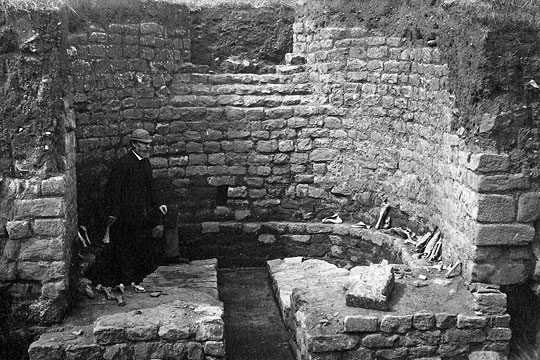Research on Chesters Roman Fort
While our understanding of the structural archaeology of Chesters is poor because of the lack of modern excavation, a number of recent discoveries and research projects offer new information on particular aspects of the site.

Excavation
There has been hardly any excavation of the fort at Chesters since 1895. Because almost all the visible remains were unearthed before then, there is much about them that today cannot be understood. A modern archaeologist would try to understand how the layers and structures on the site had built up and could be dated by associated finds.
The Victorian excavators on the other hand simply dug until they reached remains solid enough to display, collecting any spectacular finds along the way. Hardly any systematic record was kept of the excavations or of what was removed.
Our understanding of Chesters’ history will remain incomplete until further excavations using modern techniques take place. Much of what we surmise is therefore based on what has been learned in more recent excavations at other Hadrian’s Wall forts.
As there has never been any excavation in the civilian settlement (vicus) at Chesters, its likely history also has to be based entirely on what is known at other Roman forts in the north.
Other Research on Chesters Roman Fort
We now have an unusually complete record of the units in garrison here in the Roman period. Important inscriptions have continued to be found at Chesters, in the river or eroding out of the river bank, most recently in 1978 and 2004.[1]
Geophysical survey of the fort interior by English Heritage in 1992 filled some of the gaps between the Victorian excavation sites, showing a granary west of the principia, more barracks in the northern part of the fort, and interval towers between the north gate and the corner of the fort.[2]
A new plot of the aerial photographs of the civilian settlement (vicus) in 1992–3 showed it to be more extensive than previously shown.[3] Geophysical survey in 2003 revealed further details of the vicus.[4]
Gaps in Knowledge
- The nature of the occupation and the unit in garrison between the Hadrianic ala Augusta and the later ala II Asturum remains uncertain. It is not known if the fort was occupied at all in the period around AD 140–60 when the army moved north to occupy the Antonine Wall in Scotland.
- It is not possible to reconstruct a detailed overall plan of the fort, nor do we understand how this changed over the three centuries that the fort was occupied.
- The arrangement of the barracks is not known. Research at other Wall-forts and on the Continent has shown that the normal method of accommodating cavalry was not in separate barracks and stables, but with men and horses accommodated under the same roof (with a troop of 30 men and horses occupying each barrack, three to each set of rooms – horses in the front room, men in the rear). It is assumed that the barracks at Chesters would have been arranged on the same principle, but this has never been established by excavation.
- Although a plan of the civilian vicus outside the walls has been obtained from aerial photography, without excavation nothing can be known about the history of this settlement, how it originated, developed and expanded, or when it was abandoned.
READ MORE ABOUT CHESTERS ROMAN FORT
Footnotes
1. RSO Tomlin, RP Wright and MWC Hassall, The Roman Inscriptions of Britain, vol 3: Inscriptions on Stone 1955–2006 (Oxford, 2009), nos. 3298–9.
2. Unpublished, but reproduced in N Hodgson, Hadrian’s Wall 1999–2009 (Kendal, 2009), 109, fig 27.
3. Unpublished, but reproduced in P Bidwell, Hadrian’s Wall 1989–99 (Carlisle, 1999), 116 and fig 32, and on 32 of the 2011 English Heritage guidebook.
4. BC Burnham et al, ‘Roman Britain in 2003’, Britannia, 35 (2004), 273 and fig 8 [subscription required; accessed 8 March 2015].